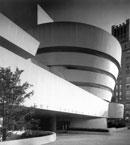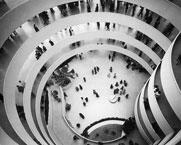The Guggenheim Museum is located in New York and is one of the landmarks designed by the famous architect, Frank Lloyd Wright. It is situated on the East Side of Manhattan and serves as an exhibition space for different types of art. The structure’s conical shape speaks about its importance as one of the true symbols of modern art. The museum was constructed in 1959 because Solomon Guggenheim’s Foundation needed a bigger exhibition space to showcase different works of art (Cohen 3). By the time the new museum was officially opened, both Guggenheim and Wright had already died, but it managed to capture many people’s imagination. However, it has managed to maintain its appeal due to its revolutionary design, which incorporates different elements of form and function.
The museum was built for artists, exhibitors, and art lovers who have an interest in sampling different artworks. It was intended to serve visitors from all walks of life who are attracted to a wide range of artistic forms. Different art collectors were encouraged to bring their works to the museum, and it caters to a wide variety of artistic preferences. The building’s exterior design communicates its purpose as space where the free flow of ideas is encouraged (Sirefman 299). Moreover, the building’s spiraling interior increases visitors’ curiosity and arouses them to marvel at different works of art displayed in its galleries. Its concave slanting walls are used to expose its bold architectural concepts which have managed to withstand the test of time in a fast-paced urban environment. As a result, visitors explore different exhibits as they descend from the ramp to the lower levels of the building. This enables them to interact intimately with artworks showcased in the museum.
During the 1940s and 1950s, most buildings in Manhattan had block shape designs. Guggenheim and Wright put up a structure using unique building materials, and due to different problems, the work began in 1956 and was completed in 1959. The structure’s inner spatial arrangement is in the form of a spiral ramp that looks like a coiling snail. The intricate design of slanting walls, oval shapes, and triangles shows the architect intended to make the structure to have an enduring appeal for generations to come. Wright created an architectural spectacle which set trends for new postmodern building concepts that were later developed from the 1960s. The use of shale concrete gave its interior a smooth texture, and this enabled a variety of color shades and hues to be used (Sirefman 301). The winding, concave structure allowed the inclusion of the skylight on the roof, which illuminates inner spaces to make exhibits more visible.
Precast, concrete blocks were used to give the structure more stability to help it withstand its spiral shape. The spiral ramp was supported by strong, rigid slabs to ensure that the rising plane was able to connect freely to the base near the exit. Other wall designs were made to conform to the spiraling shape of the ramp to ensure that they blended freely with the overall concave exterior of the structure. As a result, this inner spatial design allows visitors to view the roof, walls, and the floor at the same time while descending on the ramp, to appreciate the emptiness that links them. However, the addition of the limestone annex next to the original structure in 1992 incorporated a cubist three-dimensional design (Sirefman 306). This new design conforms to changes in the modern fast-paced urban environment of Manhattan, where different cultural concepts merge to allow the free flow of ideas.
The façade of the building has been maintained to ensure it does not lose its original appearance. The white paint on internal walls has been maintained to ensure that different exhibits on display are viewed from a natural background that allows visitors to appreciate their unique elements. This relates well with the lighting schemes used in the museum because they make it possible for visitors to differentiate tones, hues, and shades used to display various art forms (Storrer 72). More importantly, they can explore various exhibits from both low and elevated points of view. The floor plans are seamlessly linked, allowing visitors more freedom to walk around. This shows that pragmatism was one of the main ideas that influenced Wright’s design of the museum.
The ability of Wright to create a structure where different manifestations of form and function are intertwined makes this building an architectural icon. The Guggenheim Museum is a symbol of new ideas because its architectural design makes visitors understand the connections between art and modernity. The galleries are displayed in a spiral pattern which entices visitors to explore different ideas and emotions which are expressed by various artworks on display (Storrer 79). More importantly, Wright and Solomon Guggenheim took risks which resulted in a futuristic design that continues to inspire many other museums of modern art in different parts of the world.


Works Cited
Cohen, George N. Frank Lloyd Wright’s Guggenheim Museum. New York: The Aberdeen Group, 1958. Print.
Sirefman, Susanna.” Formed and Forming: Contemporary Museum Architecture.” Daedalus 128.3 (1999): 297-320. Print.
Storrer, William Allin. The Architecture of Frank Lloyd Wright: A Complete Catalog. Chicago: University of Chicago Press, 2001. Print.